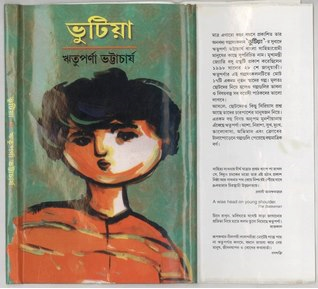Dec 26, 2025
Dec 26, 2025
by Pooja Sharma
Introduction
 Like Anne Frank's Diary , Rituparna Bhattacharjee’s Bhutiya also reveal the feelings of a child prodigy. They chronicle the thoughts and feelings of a young sensitive mind which bleeds under the pressure of dismal surrroundings . While Anne described in her tortured sensitivity as a child, Rituparna also in her stories of BHUTIYA betray a down –to –earth reality through snapshots of poverty, criminality, and selfishness.
Like Anne Frank's Diary , Rituparna Bhattacharjee’s Bhutiya also reveal the feelings of a child prodigy. They chronicle the thoughts and feelings of a young sensitive mind which bleeds under the pressure of dismal surrroundings . While Anne described in her tortured sensitivity as a child, Rituparna also in her stories of BHUTIYA betray a down –to –earth reality through snapshots of poverty, criminality, and selfishness.
The Article
Rituparna Bhattacharjee’s name as a child prodigy is well known in Bengali Children literature. Her short stories are simply outstanding for the mature vision reflected in them and for the wonderful language used for telling life’s experiences. As if written in a diary, the stories captivate our attention. This maturity is rare even for the grown up ones, but Rituparna no less in the manner of Anne Frank showed her awareness of the tragedy of life at the age of 11. This was really astonishing and something more than expected even of a child prodigy. Wikipaedia recognized her as a child prodigy and her name is figured there beside Harold Bloom and Thomas Chatterton, Lucretia Maria Davidson , Barbara Newhall, Henriett Seth F. and Lope de Vega all of whom wrote before reaching 12. Lucretia Maria by 11 years wrote some poems of note, Majorie Fleming also became a half published poet before the age of nine. Henriett Seth had a long history of visual art, poetry, and writing in her childhood beginning at the age nine and at age thirteen. What is great about Rituparna is that she like Barbara Newhall, another child prodigy who began working on fiction at 8, tried her hands in story writing. The stories Rituparna had written were just wonderful reminding us of Lope de Vega who wrote his first play at 12 years age
 The first of the stories 'Mrityunjoy' (Conquest of Death) which got second prize in the Suktara Short story contest deals with the invention of medicine for curing Cancer. Dr. Sen in this story experimented the medicine on a dog which was saved from certain death. But Dr. Sen himself died because of too much strain taken for the invention and research for a prolonged period of ten years. This is a story of commitment and devotion. Many critics and reviewers have thought that Rituparna has mused too much on death and foreboding. But this story is a positive one. It shows a journey from darkness of despair to light. It is hard to imagine that Rituparna wrote the story only at the age of 11.
The first of the stories 'Mrityunjoy' (Conquest of Death) which got second prize in the Suktara Short story contest deals with the invention of medicine for curing Cancer. Dr. Sen in this story experimented the medicine on a dog which was saved from certain death. But Dr. Sen himself died because of too much strain taken for the invention and research for a prolonged period of ten years. This is a story of commitment and devotion. Many critics and reviewers have thought that Rituparna has mused too much on death and foreboding. But this story is a positive one. It shows a journey from darkness of despair to light. It is hard to imagine that Rituparna wrote the story only at the age of 11.
The second story 'Tin Macher Galpo' (A story of three fish) , dealt with the selfishness and cruelty of the two red and blue fishes with the dark fish.The child prodigy Rituparna in this story in very simple terms analysed the pain and repentance in the mind of the offenders. The third story of the book is quite fanciful 'Putulra jadi baro hoto' (Had the Dolls been Growing Up!) and Rituparna imagines that one of the toy dolls named Rambo ,chased a thief and in course of its action was killed by criminals.
Another story 'Babar Upahar' (Gift of a Father) tells us how a teenager girl experienced the tragedy of her father accident and death during her end exam of school board. She stood first which the father dreamt of so much but could not live to see.
The other story 'Shei Cheleta' (That Very Boy) is a sad picture of a poor boy who was not allowed to participate in the Tagore Birthday celebration. Love for animals is one of the central motif in Rituparna's stories. One such story. 'Abyakto jantrona' in which Rituparana described the poignant sufferings of cat from illness. Its death is graphically described in the story.
Narrative art of Rituparna reaches a height of maturity in the story ‘Trijama’ in which the baby girl Tiku (nickname of Trijama) who loved her auntie Jhim grew up with a tragic experience of her elderly friend Akash dying of brain cancer and later when she herself sacrificed her kidney for Jhim did not herself get any support for her ailment from that ingrateful aunt Jhim. She died a tragic death .The next story ‘Thakuma’ (Grandmother) was a tragic story of an old grandmother’s suffering and sacrifice who gave her kidney for her daughter in law who always devised ways of torturing her. The old woman died and not a single tear was dropped for her.In ‘Shyamar Itikatha’ (The Age Old Story of Shyama) Rituparna tells the story of a parrot Shyama who was unfortunate enough to prove her better talents to the king because of the neglect and carelessness of the owner.
Rituparna in her story ‘Smriti’ tells about a pigeon which developed an intimacy with a tourist (the first person narrator) at Ghatshila. She nursed the wounded pigeon there in the house where she had lodged and at the time of departure, the pigeon brought a grape probably out of love and gratefulness for the narrator. Silent gestures of animals and birds always become great themes to make Rituparna’s story ever touching.
In the story ‘ Shei Hanshta’ (The Duck) the focus is on the mingling of the festivity of birthday party and the sadness associated with the death of a beloved duck. Thus Rituparna always smiled in her story with tears trickling down her cheeks. ‘Kriti’ is also the ever tragic story of a girl who could feel for everyone’s sufferings. Her artistic soul strongly reacted to the darkness all around. ‘Bhalobasar Tori’ (The Boat of Love) is a story of sibling jealousy about which Rituparna has written several times in Unish Kuri, an ABP publication. ‘Abhiman’ (Wounded Sentiment) is the sweet story of Srutika – where Rituparna reveals the values of friendship and its renewal.
Questions of promise-keeping loom large in ‘Protignya Baro Na Kartobyo?’ (Promise versus Duty) . A poor man can give his life for keeping promise. In ‘Sarthok Shilpi’ (The Successful Artist) we hear the story of a girl gradually growing up and gaining name and fame as artist by overcoming the lashes of poverty. The last but not the least is ‘Bhutia’ the title story of the book is a marvelous narrative dealing with the psychological and moral conflicts in the mind of the narrator regarding the hanging of the outlawed person Bhutia who had once been a faithful and ever loyal servant of their house. He later turned a criminal and the narrator was to dispense justice overcoming all her softness and affection. Duty is above everything even above sentiments or personal feelings.
All these stories show an abundance of grief. But still the easy grace of narration and choices diction of Rituparna make us forget the sadness associated with the tragic stories. A child suffering torments of life or watching cruelties, selfishness, sickness all around her gradually grows up in this storybook.
Rituparna’s stories do not show fairy or angels of the ethereal world. They betray a down –to –earth reality through snapshots of poverty, criminality, and selfishness. This maturity is rare for grown up ones, but Rituparna shows her awareness of this tragedy of life at the age of 11. This is really astonishing and something more than expected even of a child prodigy. Her book should be translated in English for the wider range of teenagers all over the world by the renowned publishing houses. Like Anne Frank’s Diary, BHUTIYA in some ways may also be called the ‘Diary of a Young Girl’.
At present she is a celebrity in Chemistry research with her Science Poster being selected in the University of California and Colorado and paper published in the Journal of Physical Chemistry of the American Chemical Society. But still the authoress of Bhutiya is a wonderful freelancer for the magazines like Unish Kuri of Ananda Bazar Group of publications or a brilliant writer of Advertorials for Sananda, Desh and the Ananda Bazar Patrika itself. Many child prodigies could not maintain their writing flair when they grow up. But Rituparna continues. A researcher in science with global recognition is also a committed soul to fiction writing- this is a great fact to be considered by our generation of young readers.
13-Oct-2013
More by : Pooja Sharma

|
O what a news ! I read about Rituparna long ago in Aajkaal patrika which made a headline when the then Chief Minister released the book. But after that I read her articles on Unish Kuri of the famous ABP group. Now I am really amazed to know that her Science articles are published in many Research Journals of the USA including the well known Journal of Physical Chemistry of American Chemical Society. I congratulate her on such literary and academic activities in which she has kept herself busy and preoccupied. |

|
Wonderful article by Poojaji. Kudos kudos... for the beautiful analysis. |

|
I am really happy to read this kind of article. Kindly inspire the young by publishing this kind of article. Now a days such creative talent is rare and many are going for the glam world.Writing stories at this tender age is really wonderful |

|
I am really elated to read this article on a child prodigy enlisted by Wikipedia. She continues her academic goals and also the creative writings simultaneously. A great feat indeed. |

|
I am really delighted to know that Pooja Sharma has beautifully explored and analysed the stories of Rituparna's debut short story collection in this article. She is a creative writer. Usually children write poems and do paintings at their tender age. But to write 17 beautiful stories in very good Bengali which even Syed Mustapha Siraj had praised personally in his letter to Rituparna , is really a stupendous creative feat. |

|
It is a wonderful write up by Pooja Sharma. Yes, many child prodigies do not continue in their later age. But Rituparna is doing marvellously well at the same time taking care for her studies. She is an inimitable example |